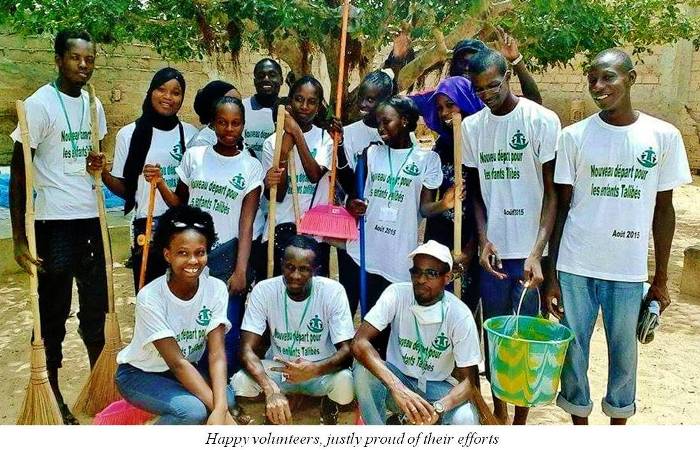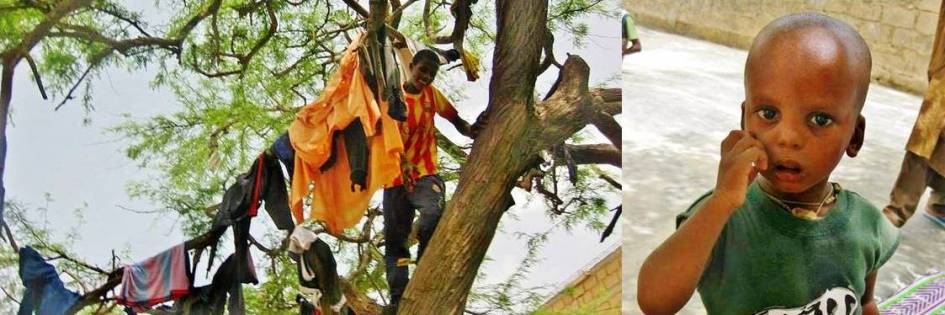News from Maison de la Gare
Meeting the Talibé Children in the Daaras Where They Live
Tweeter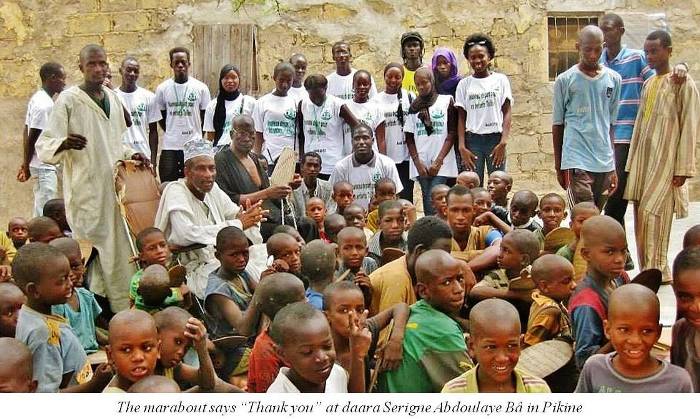
"Davis Projects for Peace" volunteers throw light on this hidden world, while making it a bit better
Four students at the University
of Rochester in New York conceived and led a remarkable mobilization of Senegalese
university students during the summer of 2015, in support of Maison de la Gare's
work for the begging talibé street children … "A
New Beginning for the Talibé Children".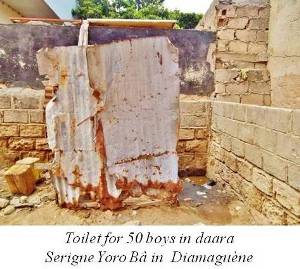
With its long experience in this struggle, Maison de la Gare was able to help
Rose Mbaye, Eyram Adedze, Ben Ouattara and Mame Coumba to understand the situation
that had led to establishment of its welcome center in Saint Louis. And, to help
them to take action towards eradicating the so-called education system maintained
by false Quranic teachers, and to appreciate the challenges that must be overcome.
In its 2010 report "Off the Backs of the Children", Human Rights Watch described
the lives of the talibé children in their daaras in this way:
“Morning to night, the landscape of Senegal’s cities is dotted with the sight
of the boys -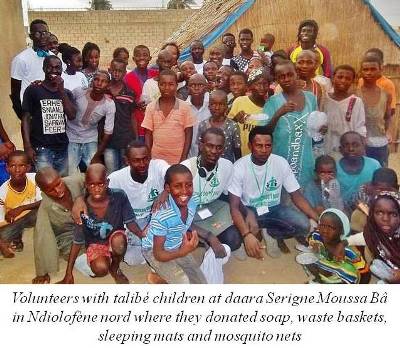 the vast majority under 12 years old and many as young as four -
shuffling in small groups through the streets; weaving in and out of traffic;
and waiting outside shopping centers, marketplaces, banks, and restaurants.
Dressed in filthy, torn, and oversized shirts, and often barefoot, they hold
out a small plastic bowl or empty can hoping for alms. On the street they are
exposed to disease, the risk of injury or death from car accidents, and physical
and sometimes sexual abuse by adults.
the vast majority under 12 years old and many as young as four -
shuffling in small groups through the streets; weaving in and out of traffic;
and waiting outside shopping centers, marketplaces, banks, and restaurants.
Dressed in filthy, torn, and oversized shirts, and often barefoot, they hold
out a small plastic bowl or empty can hoping for alms. On the street they are
exposed to disease, the risk of injury or death from car accidents, and physical
and sometimes sexual abuse by adults.
Daily life for these children is one of extreme deprivation. Despite bringing
money and rice to the daara, the children are forced to beg for their meals on
the street.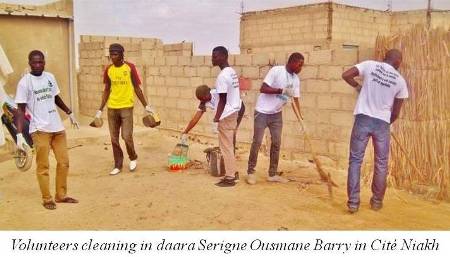 Some steal or dig through trash in order to find something to eat.
The majority suffer from constant hunger and mild to severe malnutrition. When
a child falls ill, which happens often with long hours on the street and poor
sanitary conditions in the daara, the teacher seldom offers healthcare assistance.
The children are forced to spend even longer begging to purchase medicines to
treat the stomach
Some steal or dig through trash in order to find something to eat.
The majority suffer from constant hunger and mild to severe malnutrition. When
a child falls ill, which happens often with long hours on the street and poor
sanitary conditions in the daara, the teacher seldom offers healthcare assistance.
The children are forced to spend even longer begging to purchase medicines to
treat the stomach 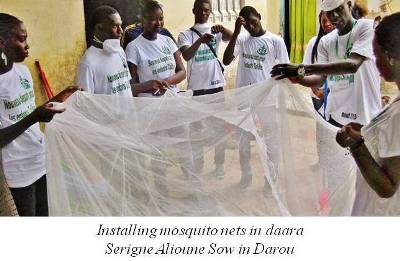 parasites, malaria, and skin diseases that run rampant through
the daaras. Most of the urban daaras are situated in abandoned, partially
constructed structures or makeshift thatched compounds.
The children routinely
sleep 30 to a small room, crammed so tight that, particularly during the hot
season, they choose to brave the elements outside. During Senegal’s four-month
winter, the talibés suffer the cold with little or no cover, and, in some cases,
even a to sleep on.”
parasites, malaria, and skin diseases that run rampant through
the daaras. Most of the urban daaras are situated in abandoned, partially
constructed structures or makeshift thatched compounds.
The children routinely
sleep 30 to a small room, crammed so tight that, particularly during the hot
season, they choose to brave the elements outside. During Senegal’s four-month
winter, the talibés suffer the cold with little or no cover, and, in some cases,
even a to sleep on.”
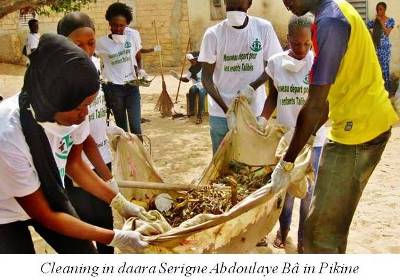
The Senegalese university students were able to see with their own eyes the
children’s living conditions in Saint Louis daaras, and to appreciate the
difference between a good and a bad daara. They visited seven of the daaras
where the children live In the course of the project, donating sleeping mats,
soap, shoes, clothing and first aid supplies.
They also undertook a major
clean-up of these daaras, sweeping and removing refuse, and they donated brooms
and waste bins and
installed mosquito nets, all to allow the children to live
in slightly better conditions. In daara Serigne Abdoulaye Bâ
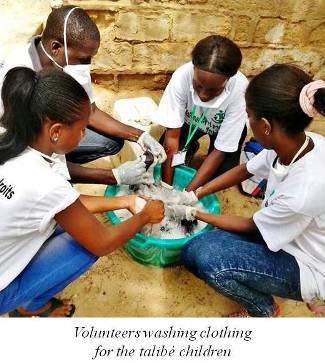 in Pikine the
volunteers washed the young talibé children’s clothing, providing an example for
others to follow.
in Pikine the
volunteers washed the young talibé children’s clothing, providing an example for
others to follow.
These visits also gave the students the opportunity to express directly to the
Quranic teachers, the marabouts of the daaras, their lack of support for the
philosophy responsible for the children’s situation. From these discussions,
the idea emerged of carrying out some renovations in order to make a real
difference for the children. Many of the daaras have no means of providing
health care and no provision for basic hygiene. As an example, in daara
Serigne Alioune Sow in the Darou area, the volunteers installed showers and
built a new toilet facility.

By the end of this project, a network of new friends had developed among the
university student volunteers. Together they had come to understand that the
condition of the children living in these daaras is a Senegalese problem that
must be resolved by the Senegalese themselves. The project transformed the
volunteers’ perceptions of the situation of these very vulnerable children.
And it gave the children themselves new hope that there are Senegalese men
and women who are aware of their situation and are committed to giving them
the chance to have a better life.
